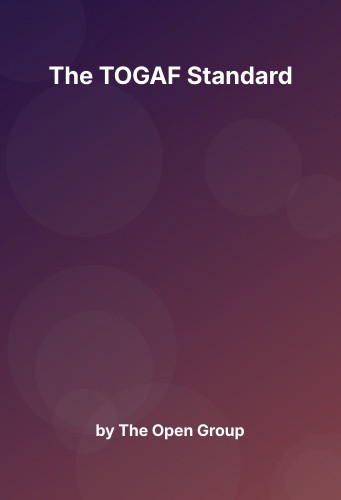Summary
The TOGAF Standard, developed by The Open Group, is one of the most widely adopted enterprise architecture (EA) frameworks in the world. It provides a comprehensive approach to designing, planning, implementing, and governing enterprise information architecture. TOGAF helps organizations align business and IT strategies, ensuring that technology supports the achievement of strategic objectives.
Originally released in 1995 and updated continually, TOGAF is now in its 10th Edition and supports both traditional architecture development and modern agile and digital practices. The framework is vendor-neutral, scalable, and flexible.
Why TOGAF Matters
Enterprise architecture provides the structure and discipline needed to manage complexity and drive transformation. TOGAF helps organizations:
- Improve business-IT alignment
- Reduce redundancy and cost
- Enhance agility and responsiveness
- Support digital transformation initiatives
It enables organizations to create a holistic view of their architecture, spanning business, data, applications, and technology.
The Architecture Development Method (ADM)
At the core of TOGAF is the Architecture Development Method (ADM), a step-by-step approach to developing and managing EA. The ADM cycle includes:
- Preliminary Phase – Establish architecture capability and governance.
- Phase A: Architecture Vision – Define the high-level vision, scope, and stakeholders.
- Phase B: Business Architecture – Develop business strategy, processes, and governance models.
- Phase C: Information Systems Architecture – Split into Data and Application Architecture.
- Phase D: Technology Architecture – Define the IT infrastructure.
- Phase E: Opportunities and Solutions – Identify solutions, prioritize projects, and create roadmaps.
- Phase F: Migration Planning – Develop detailed transition architectures and implementation plans.
- Phase G: Implementation Governance – Ensure delivery aligns with architectural standards.
- Phase H: Architecture Change Management – Maintain and adapt architecture over time.
- Requirements Management – Ongoing phase managing changes across all ADM phases.
The ADM is iterative, allowing for continuous refinement and responsiveness to change.
TOGAF Content Framework
The content framework provides the artifacts and building blocks used in the ADM, including:
- Architecture views and viewpoints
- Catalogs (e.g., applications, data entities)
- Matrices (e.g., business function to application mapping)
- Diagrams (e.g., process flows, infrastructure models)
It enables consistent and comprehensive documentation of the architecture.
TOGAF Enterprise Continuum
The Enterprise Continuum provides context for the architecture work, helping classify solutions from generic to organization-specific. It includes:
- Foundation Architectures – Generic building blocks (e.g., technology standards)
- Common Systems Architectures – Reusable solutions (e.g., security services)
- Industry Architectures – Sector-specific models
- Organization-Specific Architectures – Custom solutions tailored to business needs
This continuum supports reuse and accelerates architecture development.
Architecture Repository
TOGAF promotes the use of a central repository to manage EA assets. It stores:
- Models and artifacts
- Architecture metamodel
- Standards and guidelines
- Governance logs
A well-structured repository enables traceability, reuse, and compliance.
Architecture Capability Framework
This component helps organizations establish and operate an effective EA practice. It includes guidance on:
- Governance structures
- Roles and responsibilities
- EA tools and skills
- Performance management
Organizations must treat EA as a strategic capability with clear sponsorship and resourcing.
Architecture Views and Viewpoints
TOGAF distinguishes between:
- Viewpoints – Templates based on stakeholder concerns (e.g., security, usability)
- Views – Actual representations (diagrams, matrices) tailored to stakeholders
This separation ensures that architecture outputs are meaningful and actionable for their audience.
Governance and Compliance
Governance is embedded throughout TOGAF. It ensures:
- Architectures are approved through formal review
- Projects conform to standards
- Deviations are managed through waivers
Architecture boards and governance bodies enforce quality and alignment.
Agile and Digital Alignment
TOGAF has evolved to support agile, DevOps, and digital transformation. Techniques include:
- Time-boxed architecture sprints
- Just-enough architecture for MVPs
- Continuous integration of architecture into delivery pipelines
EA is positioned as an enabler of speed, not a bottleneck.
Tailoring TOGAF
Organizations are encouraged to adapt TOGAF to their context. This includes:
- Simplifying ADM phases for smaller initiatives
- Integrating with ITIL, COBIT, and PMBOK
- Using open source or commercial EA tools
Tailoring enhances relevance and adoption.
Benefits of TOGAF Adoption
- Strategic Alignment – Architecture connects strategy to execution.
- Cost Efficiency – Identifies redundant processes and systems.
- Risk Management – Provides visibility into dependencies and vulnerabilities.
- Innovation Enablement – Structures change and modernization efforts.
Enterprises adopting TOGAF report improved governance, clearer roadmaps, and more effective digital execution.
Case Study Snapshots
- A global bank used TOGAF to unify its fragmented IT landscape across regions.
- A government agency leveraged TOGAF to standardize citizen service platforms.
- A healthcare provider adopted TOGAF to integrate clinical, administrative, and data systems under a common governance model.
These examples demonstrate TOGAF’s versatility across industries.
Common Challenges
- Overengineering – Attempting to model everything at once.
- Lack of sponsorship – EA efforts stall without executive backing.
- Tool complexity – Heavy tools slow down delivery.
- Cultural resistance – Teams see EA as obstructive or academic.
TOGAF emphasizes value delivery and stakeholder engagement to overcome these challenges.
Future of TOGAF
With the release of the TOGAF Standard, 10th Edition, the framework has become more modular and adaptable. Future trends include:
- Greater emphasis on digital platforms and ecosystems
- Expanded support for agile and product-centric organizations
- Integration with data architecture and AI governance
TOGAF continues to evolve to meet modern enterprise needs.
Why This Book Matters
The TOGAF Standard is foundational for enterprise architects and IT strategists. It provides a common language and methodology to align stakeholders, navigate complexity, and enable change. Its structured approach helps organizations build coherent, responsive, and secure technology environments.
TL;DR
TOGAF is a structured enterprise architecture framework that guides organizations in aligning business and IT through a standardized, iterative process. It supports digital transformation by promoting consistency, reuse, and governance in architecture development.

